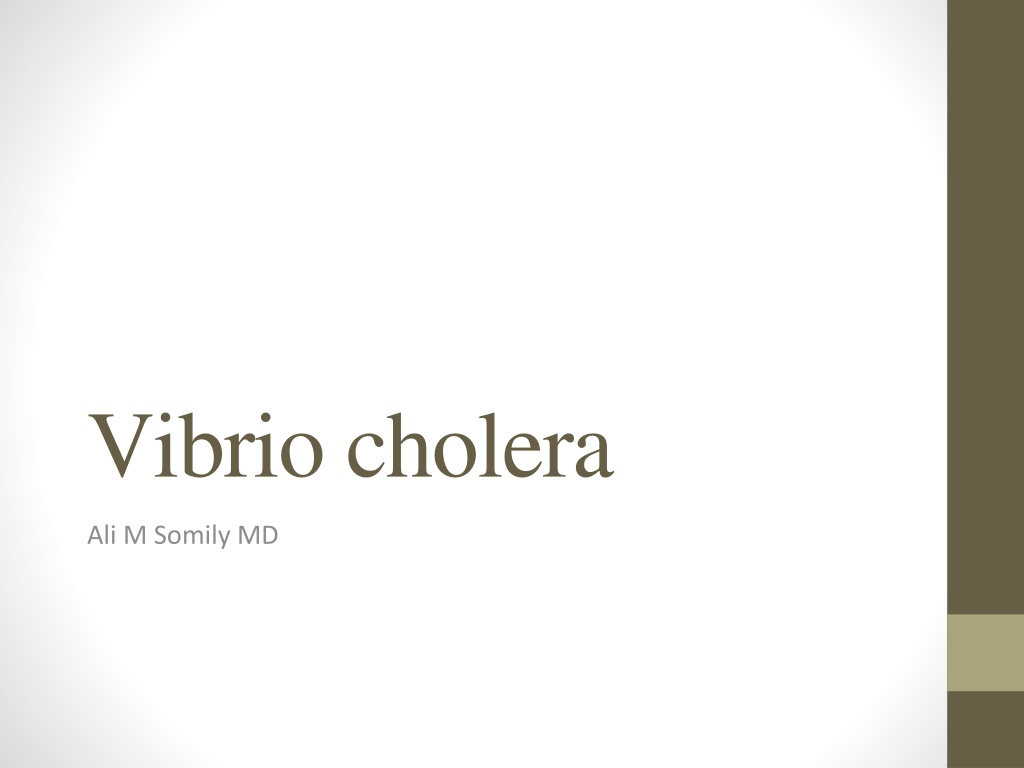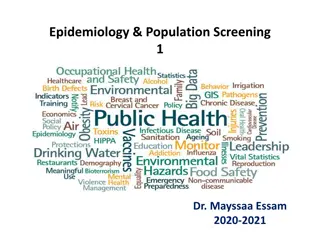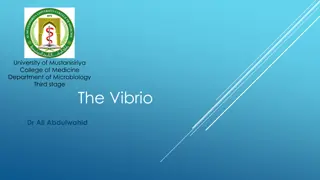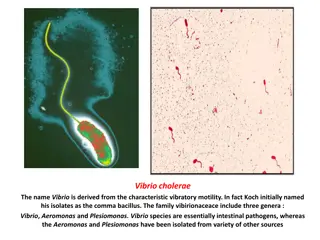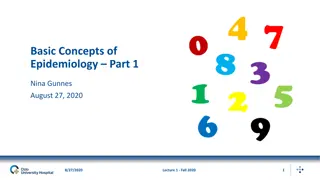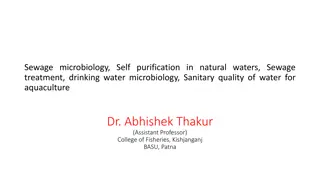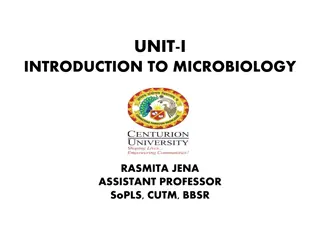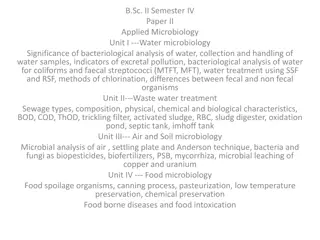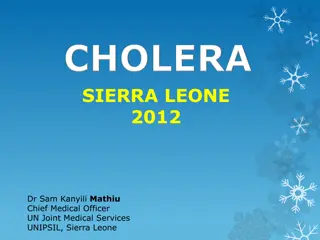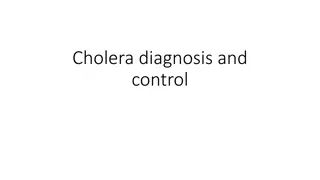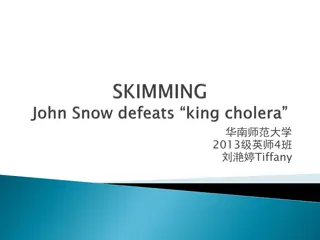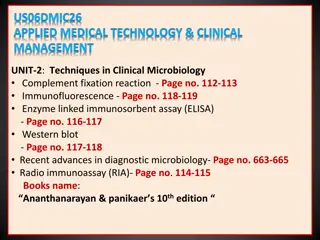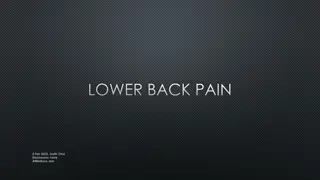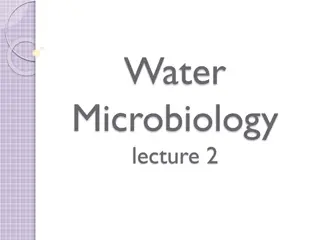Understanding Cholera: Epidemiology, Microbiology, Clinical Features, and Management
Cholera is a water-borne disease caused by Vibrio cholera, characterized by severe diarrhea. Learn about its history, microbiological characteristics, pathogenesis, clinical features, laboratory diagnosis, management, and outbreak control. Discover the epidemiology, including major outbreaks and transmission methods. Stay informed to prevent and manage this life-threatening illness.
Download Presentation

Please find below an Image/Link to download the presentation.
The content on the website is provided AS IS for your information and personal use only. It may not be sold, licensed, or shared on other websites without obtaining consent from the author. Download presentation by click this link. If you encounter any issues during the download, it is possible that the publisher has removed the file from their server.
E N D
Presentation Transcript
Vibrio cholera Ali M Somily MD
Objectives Know the epidemiology of cholera and history of cholera Know the microbiological characteristic of cholera Describe the pathogeneses of cholera Describe the clinical features of cholera Describe the methods for laboratory diagnosis Know the management of cholera and control of outbreak
Introduction A water born live threatening diarrheal disease. Caused by vibrio cholera which is a comma- shaped gram- negative rods. Found in salt and fresh water. Has many serotypes based on O-antigen. O 1 and O 139. Produce a non-invasive enterotoxin. leads to outbreak and epidemic. Can be prevented by good sanitation system.
Discovery John Snow discovered an outbreak in London 1854 It was related to broad street pump sewage contamination. Removal of the pump handle end of the outbreak.
Epidemiology V. cholera O1 and O139 serogroup organisms are the causes of epidemic cholera. O1 ( from1817 till now) Classical: 1 case per 30-100 infections El Tor: 1 case per 2-4 infections (Seventh pandemic) O139 ( recently in 1992 in Asia only) Contained in India, Bangladesh. Seven major outbreaks. Majority in India, Sub-Saharan Africa, Southern Asia. Endemic in > 50 countries. Each year 3-5 millions cases result in 100,000 deaths.
Epidemiology In 2016 in Haiti after Hurricane Matthew, in South Soudan and Yemen and many other African countries
Transmission Fecal- oral transmission through contaminated food or water. Common in summer grows in brackish estuaries and coastal seawaters, often in close association with copepods or other zooplankton. Sewage or infected person contaminate water supply. Not well established sewage system and water treatment. Under-cooked shellfish. Children, elderly and people with less gastric acidity are at higher risk then others Blood group O>> B > A > AB
Infectivity Period of infectivity during acute stage till recovery ( end one to three wks) Infected person can produce up to 20 L of 109CFU/ml /day Has high infectious dose NOT like Shigella Infectious dose 106-1011colony-forming units Due to harsh environment of the intestine ie temperature and stomach acidity and Bile salts, organic acids in the intestine
Pathogenesis (previous lecture) Vibrio cholerae uses toxin-coregulated pili (TCP) to colonize the human intestine. Cholera results from secretory diarrhea caused by the actions of cholera toxin (CT) on intestinal epithelial cells. CT is an adenosine diphosphate ribosylating enzyme that leads to chloride, sodium, and water loss from intestinal epithelial cells. GM1, a glycosphingolipid on the surface of epithelial cells enzymatic A subunit of cholera toxin mediates Nicotinamide adenine dinucleotide (NAD) Adenosine diphosphate (ADP)-ribose G protein Regulates adenylyl (adenylate) cyclase activity (AC) elevation in the intracellular cyclic adenine monophosphate (cAMP) concentration
Clinical Manifestations Ranges from a few hours to 5 days( range 1-3 days). Depending on gastric acidity and initial infectious dose. Majority have mild, or no symptoms at all 75% asymptomatic 20% mild disease 2-5% severe Vomiting, Cramps and Watery diarrhea (1L/hour) with flecks of white mucus (rice water stool) with a fishy odor Death occurred in 18 hours-several days if not treated due dehydration. Ca++and K can lead to ileus, muscle pain and spasm, and even tetany
Clinical Manifestations Cholera gravis: More severe symptoms due to Rapid loss of body fluids 6 liters/hour 107-9vibrios CFU/mL Rapidly lose more than 10% of bodyweight Dehydration and shock Sunken eyes, and skin turgor ( tenting), cold and clammy. Anuric and lactic acidosis ( Kussmual breathing). Hypoglycemia leads to seizure or comma. Cardiac and Renal failure. Aspiration pneumonia Death within 2-12 hours or less. Mortality 50-60% without treatment Mortality <1% with redehydration
Diagnosis Suspect in sever diarrhea with dehydration. Other non-invasive bacterial, ETEC and viral gastroenteritis might have similar presentation. Complete history and physical examination. Insert central line for IV fluid, collect blood for basic routine tests ( chemistry and hematology). Send stool for smear and culture on special media. Culture not routinely performed, you have to request it. Dark field microscopy (shooting stars) Gram stain (curve Gram Negative bacilli) Culture on thiosulfate citrate bile sucrose (TCBS) agar-yellow colonies Recovery of organisms can be enhanced by enrichment of stool in alkaline peptone water. (60-100%)
Microbiology VIBRIO CHOLERAE MUST SEE !! In U tube
Diagnosis/ microbiology Vibrio cholera is highly motile, gram-negative, curved or comma-shaped rods with a single polar flagellum. Biotype O 1 antigen Serotype Antigen O 139 serogroup appeared in Bangladesh 1992 Classical Ogawa A,B Inaba A,C Hikojima A,B,C Has poly saccharide capsule but does not have O1 antigen El Tor Ogawa A,B Inaba A,C Hikojima A,B,C Non-O1, Non-O139 Serogroup Most are CT (cholera toxin) negative and are not associated with epidemic disease.
Treatment Basically rehydration and antimicrobial therapy. Rehydration should be started immediately before confirming the diagnosis. Either oral rehydration if the patient can tolerate it ( not vomiting or start IV rehydration. Decrease mortality from 50% to 1 %. Give 1.5 time the amount lost. Start when 10% of total body weight lost. Patients recovered within 3-6 days. Oral Rehydration Salt (ORS) by WHO and UNICEF One pack in 1 liter contain NaCl, KCl, NaHCO3, glucose IV use either Ringer s lactate, Saline or Sugar and water
Antibiotics Reduce the recovery time to 2-3 days. Decrease infectivity Azithromycin single-dose is often the preferred therapy especially in children. Or Ciprofloxacin Or Tetracycline, Doxycycline
Can be a bioterrorism agents Ease of procurement Simplicity of production in large quantities at minimal expense Ease of dissemination with low technology Silent dissemination
Prevention Wash your hand frequently Boil water and chlorination. Cook all types of food very well. Avoid salad, ice and iced food Water Sanitation Water treatment Disrupt fecal-oral transmission if present Killed Whole-cell Vaccines Live Attenuated Vaccines Adult 50% protection for 6 months 60% protection for 2 years children aged 2-5 < 25% protection protection rapidly declines after 6 months Doses Multiple doses Side effects -------------------- Mild diarrhea, abdominal cramping
International Efforts WHO: Global Task Force on Cholera Control Reduce mortality and morbidity Provide aid for social and economic consequences of Cholera CDC U.N.: GEMS/Water Global Water Quality Monitoring Project Addresses global issues of water quality with monitoring stations on all continents
